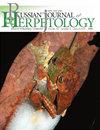Comparative Analyses of Two Nearly Complete Mitochondrial Genomes of the Liu’s Skink, Plestiodon liui, from South and North Sides of the Yangtze River
IF 0.9
4区 生物学
Q3 ZOOLOGY
引用次数: 0
Abstract
In this study we amplified and sequenced the nearly complete mitochondrial DNA of an individual of the Liu’s skink, Plestiodon liui, from south of the Yangtze River. The obtained mitochondrial genome was 17, 945 bp in length, comprising 13 protein-coding genes (PCGs), 22 transfer RNA genes, two ribosomal RNA genes and an incomplete control region (D-loop). Another nearly complete mitogenome of P. liui, from north of the Yangtze River, was retrieved from GenBank and used for comparative analyses. The results showed that the genome organization, base composition, codon usage, and gene arrangement of the mitochondrial genomes for the two individuals of P. liui were highly similar to each other. Twelve out of 13 PCGs initiated with canonical start codon (ATG), while COX1 started with GTG. The codon usage analysis revealed a preferential use of the LeuCUN, Pro, and Thr codons with the A/U ending. Among the 22 tRNA genes, only tRNA-SerAGY was not folded into a typical cloverleaf secondary structure and had no recognizable DHU stem. The phylogenetic tree inferred from Bayesian inference and maximum likelihood approaches strongly supported that the two individuals of P. liui clustered together, and formed the sister taxon to a clade of P. capito and P. tunganus. All PCGs had undergone a strong purifying selection, whereas 27 residues of the ATP6, COX2, Cytb, ND3, ND4, ND5, ND6 genes might have undergone positive selection. Bayesian molecular dating indicated that the split between P. liui and P. capito – P. tunganus was approximately 9.62 million years ago (Ma). Meanwhile, the coalescence time of the two individuals of P. liui was estimated to be 2.26 Ma with 95% highest posterior density of 1.32 – 3.28 Ma, which fell within the timeframe for the Yangtze River run-through between the late Pliocene to the middle Pleistocene. This finding implied that the Yangtze River run-through had played an important role in the diversification of the Liu’s skink.长江南北两岸刘氏胸齿兽(Plestiodon liui)两个接近完整线粒体基因组的比较分析
在这项研究中,我们扩增并测序了来自长江以南的刘氏石首鱼Plestiodon liui个体的几乎完整的线粒体DNA。获得的线粒体基因组长度为17945bp,包括13个蛋白质编码基因(PCG)、22个转移RNA基因、两个核糖体RNA基因和一个不完全控制区(D-loop)。从GenBank中检索到了另一个几乎完整的长江以北地区柳的有丝分裂基因组,并进行了比较分析。结果表明,这两个个体的线粒体基因组组织、碱基组成、密码子使用和基因排列高度相似。13个PCG中有12个是由经典起始密码子(ATG)启动的,而COX1是由GTG启动的。密码子使用分析显示优先使用以a/U结尾的LeuCUN、Pro和Thr密码子。在22个tRNA基因中,只有tRNA SerAGY没有折叠成典型的三叶草二级结构,并且没有可识别的DHU茎。根据贝叶斯推断和最大似然方法推断出的系统发育树有力地支持了刘氏P.liui的两个个体聚集在一起,并形成了头状P.capito和通氏P.tunganus分支的姐妹分类单元。所有PCG都经过了强烈的纯化选择,而ATP6、COX2、Cytb、ND3、ND4、ND5、ND6基因的27个残基可能经过了阳性选择。贝叶斯分子年代测定表明,P.liui和P.capito–P.tunganus之间的分裂大约在962万年前(Ma)。同时,刘两个个体的聚结时间估计为2.26 Ma,95%的最高后密度为1.32–3.28 Ma,处于上新世晚期至更新世中期长江贯通的时间范围内。这一发现暗示了长江的贯通在刘的皮肤多样化中发挥了重要作用。
本文章由计算机程序翻译,如有差异,请以英文原文为准。
求助全文
约1分钟内获得全文
求助全文
来源期刊

Russian Journal of Herpetology
ZOOLOGY-
CiteScore
1.70
自引率
0.00%
发文量
29
期刊介绍:
Russian Journal of Herpetology is an international multi-disciplinary journal devoted to herpetology. Russian Journal of Herpetology accepts original papers on ecology, behavior, conservation, systematics, evolutionary morphology, paleontology, physiology, cytology and genetics of amphibians and reptiles.
Types of Contributions:
-original papers
-invited or contributed reviews on specific topics
-short communications on topics of immediate interest, new methods and ideas in progress
-notices of meetings, symposia, and short courses
-book reviews
 求助内容:
求助内容: 应助结果提醒方式:
应助结果提醒方式:


